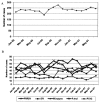Retrospective analysis of etiologic agents associated with respiratory diseases in pigs
- PMID: 14524628
- PMCID: PMC340270
Retrospective analysis of etiologic agents associated with respiratory diseases in pigs
Abstract
Twenty-eight hundred and seventy-two cases of respiratory disease in pigs were analyzed for their etiologic agents. Two or more pathogens were detected from 88.2% of the cases, indicating that porcine reproductive and respiratory syndrome virus (PRRSV) or swine influenza virus (SIV) combined with other bacterial agents was a common cause for porcine respiratory diseases in the mid-western USA.
Figures

References
-
- Halbur PG. Porcine respiratory diseases. Proc 15th Congr Int Pig Vet Soc 1998:1–10.
-
- Fuentes MC, Pijoan C. Pneumonia in pigs induced by intranasal challenge exposure with pseudorabies virus and Pasteurella multocida. Am J Vet Res 1987;48:1446–1448. - PubMed
-
- Yagihashi T, Nunoya T, Mitui T, Tajima M. Effect of Mycoplasma hyopneumoniae infection on the development of Haemophilus pleuropneumoniae pneumonia in pigs. Nippon Juigaku Zasshi 1984;46:705–713. - PubMed
-
- Zhou NN, Senne DA, Landgraf JS, et al. Emergence of H3N2 reassortant influenza A viruses in North American pigs. Vet Microbiol 2000;74:47–58. - PubMed
MeSH terms
LinkOut - more resources
Full Text Sources
